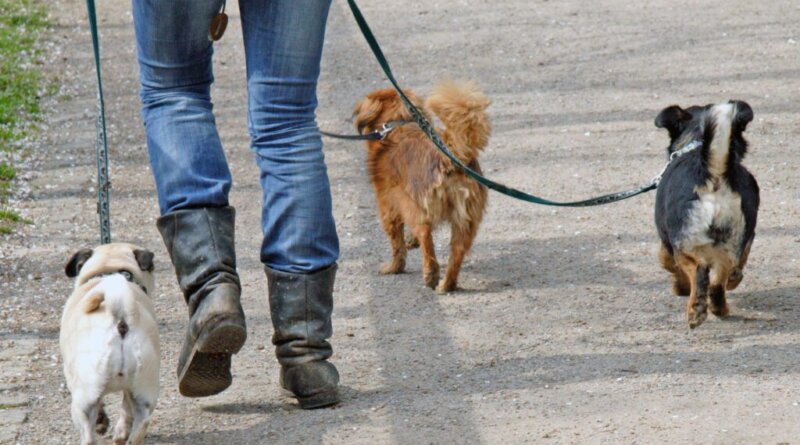You Can Walk Two Dogs at Once
Of course, you can walk two dogs at once, or, as I do, sometimes three. If you can’t walk two of your own dogs at the same time, it’s a training problem and, usually, the problem is distractions—things the dog(s) want, causing them to get excited and out of control. That can be trouble with two dogs on leash together. You can only walk two dogs at once if they know each other and are both calm and trained to walk on leash.
Twenty years ago, I learned that the hard way—trying to manage my three Shelties in a frenzy due to a passing car! I learned what happens when your dog isn’t taught to ignore distractions when tasked to do so. And now, I always include this lesson in my basic classes. Just imagine walking two dogs at once when one sees a squirrel . . . Let’s begin.
Basics
First, you don’t need any special equipment. Here’s all you need:
- A well-fitted collar or harness
- A leash no longer than six feet (absolutely no retractable leashes)
- Treats (lots of good ones)
Pulling is sometimes part of the issue when walking two dogs, or with one dog for that matter. If you have a puller, work on that before walking two dogs at once. A good training device to help with that is Pet Safe’s Gentle Leader, which is a brand of head collar that puts pressure on top of the nose when the dog pulls. It’s all on them.
Dogs find it annoying but not painful. When they get used to it, all you do is put it on and the dogs know. To wean them off the apparatus, you can slide it off their nose and just have it hang from their neck. However, they are not allowed slide it off themselves.
You can purchase all sorts of things for walking two or more dogs at once, like coupler devices that allow you to put both dogs on one leash, but these things don’t solve any problems. Plus, we prefer each dog has a bit of freedom to sniff what he wants to sniff without his friend in tow. The walk is for all to enjoy, after all.
Walk the dogs with the leashes in whatever way is most comfortable for you. Do you want them both on one side? Do you want a leash in each hand or both leashes in one hand? There’s no strict right or wrong here, but you should be consistent.
Start With One Dog
In this short piece, we are going to focus on distraction training and assume your dog knows how to walk quietly on a leash and other basic commands like sit, wait, and a release cue. If not, you need to read “Polite Leash Walking.”
We want to work on handling distractions—because holding ONE squirrel-obsessed dog is difficult enough—and teaching your dog to focus on you.
So, stuff your pockets with the best treats ever. Take one dog at a time and go for a walk, away from anything that might trigger a strong reaction like cars and squirrels. Periodically, ask him to sit, treat, and release. Repeat this multiple times. He needs to understand that asking him to sit while on a walk will be nicely rewarded.
Eventually, as he becomes increasingly attentive to you, maybe over a period of a week or two (depending upon the dog), work your way toward passing traffic (he’s still not ready for squirrels). As a car approaches, ask your dog to sit, treat, and release. And take him to places where there are even more distractions. It’s important that your dog listens to you. Do the same if he gets excited when he sees other people, other dogs, and eventually squirrels.
Do this same training step with your other dog, too. Take your time.
Putting Them Together
When your dogs have met your walking criteria individually, such as sitting on cue even when something tantalizing is nearby, take them for a walk together in a quiet area. Practice away from traffic, then gradually introduce triggers and distractions. They should both sit on cue and be rewarded. Make the intensity of the triggers gradually more difficult.
Not successful? Go back to square one. (Someone once said, “Don’t complain, train!” But no one ever said it was easy.)
It didn’t take long for my Shelties to lose their interest in passing cars, but squirrels took longer. Be patient. Use good treats.
Every two months I have six or eight new dogs enrolled in my basic class at K9Capers. The dogs are all at least 6 months old, and most have never had any formal training (dogs or trainers).
When the doors open for the first class, dogs often pull their handlers into the facility, eager to see other dogs, people, and this exciting, new place. Some dogs are scared. Some are exuberant. Owners have little control, sore shoulders, and worried expressions. The first class is usually rather disruptive until I get everyone situated, and the first thing we learn is the sit and treat.
I often make suggestions when I teach, but handlers make the final decision. Some of the owners are resistant to head collars, so I let them come around on their own. They soon learn that a dog cannot learn anything if he is not focused. Eventually, one by one, each owner tried a head collar. And they practice sit and treat.
As the session progresses, reports come in about the enjoyable walks owners were having with their dogs at home. Many walking two dogs at once!
I can often be seen in the neighborhood pushing a stroller with my elderly Sheltie inside, and a couple of Goldens or Shelties trotting alongside. Folks are amazed that I can do this with my dogs. I tell them, “No magic here … just training.”




